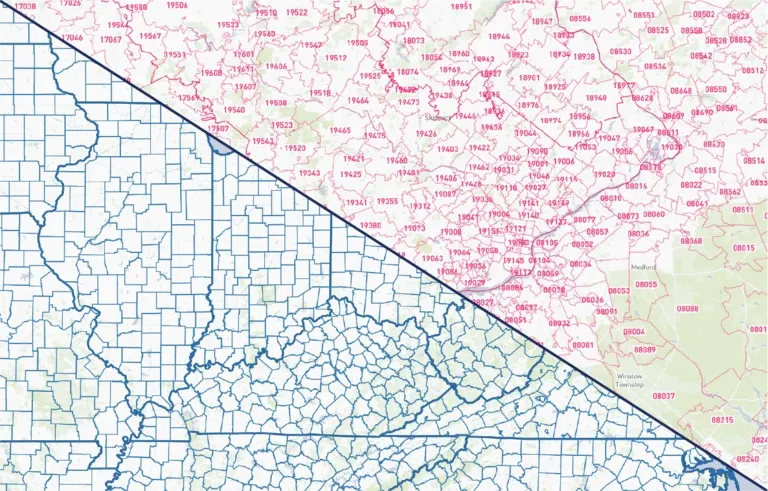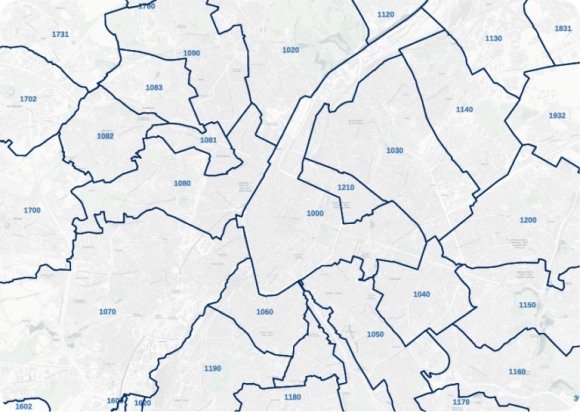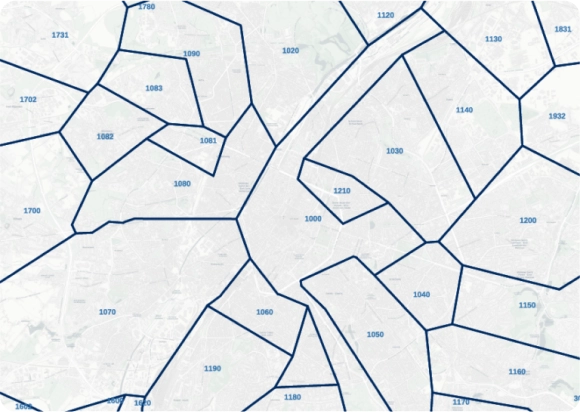Worldwide Zip Code Shapefile

Zip Code Shapefile and Administrative Boundaries Worldwide - Data Download
The complete list of administrative boundaries and zip code shapefile is available. Contact us.
| ISO | Geom | Level | Name_lang1 | Type |
|---|---|---|---|---|
| AR | MULTIPOLYGON (((-6506002.3986215405 | 2 | Comuna 14 | Municipalities |
| AU | MULTIPOLYGON (((16600454.655740766 | 2 | Canberra Central (Unincorporated) | Districts |
| CO | MULTIPOLYGON (((-78.1193199999999 | 3 | "Bogotá, D.C." | Special districts |
| CV | MULTIPOLYGON (((-24.36555999999996 | 1 | Ribeira Grande de Santiago | Municipalities |
| DE | MULTIPOLYGON (((14.225550000000055 | 3 | Berlin | District-free towns |
| FR | MULTIPOLYGON (((269675.38000000035 | 4 | Drancy | Communes |
| HR | MULTIPOLYGON (((17.745550000000037 | 1 | Grad Zagreb | Capital city |
| IL | MULTIPOLYGON (((35.62364000000008 | 3 | Judean Foothills | Natural Regions |
| JP | MULTIPOLYGON (((123.8728900000001 | 3 | Ota | Special wards |
| KH | MULTIPOLYGON (((11667388.521290326 | 3 | Prateah Lang | Quarters |
| KR | MULTIPOLYGON (((126.62221 | 0 | South Korea | Country |
| MX | MULTIPOLYGON (((-11036561.424793579 | 2 | Azcapotzalco | Boroughs |
| NL | MULTIPOLYGON (((581592.9952199023 | 2 | Laren | Municipalities |
| NZ | MULTIPOLYGON (((169.18552 | 2 | Kapiti Coast | District councils |
| RO | MULTIPOLYGON (((28.214840000000038 | 3 | București - Sectorul 1 | Municipal sectors |
| TR | MULTIPOLYGON (((3668338.7427264205 | 3 | Gölbaşı | Metropolitan District Municipalities |
| UA | MULTIPOLYGON (((38.23582000000005 | 0 | Ukraine | Country |
| US | MULTIPOLYGON (((-155.00557999999992 | 2 | Nantucket | Counties |
| UY | MULTIPOLYGON (((-53.37429999999995 | 0 | Uruguay | Country |
PRODUCT HIGHLIGHTS

Postal and Administrative Areas for 247 Countries
Coherence and precision at every level
Edge-matched polygons
Our proprietary data-mastering processes guarantee shape accuracy, featuring a topological model and a dedicated algorithm to establish spatial relationships.
- No gaps or overlaps
- No duplicate data thanks to mutualized edges
- Clean coastlines and borders
WHY GEOPOSTCODES
High-quality administrative boundaries and unique expertise
Highest quality
- Edge-matched polygons
- Precision at every level
- Proprietary topological model
Unique expertise
- Fast and agile implementation
- Dedicated GIS Expert
- 100+ successful integrations
World coverage
- 247 countries
- Difficult geographies
- Up to 6 levels

Rich attributes
Our administrative boundaries data can be enriched with country-specific information, population, multi-language support, UNLOCODE, IATA codes, and time zones.

High-precision for spatial analysis
Our high-resolution shapes are put together with up to 1-meter precision, making it perfect for in-depth spatial analysis, clustering, geofencing, and reverse geocoding.

Fast-loading for reporting and BI
Get our lightweight, simplified, yet exhaustive format for a fast rendering. Our proprietary algorithm ensures all entities remain visible and perfectly connected after simplification.
“Having postal boundary visualization works much better for customers than putting things in a table.”
William Chao
Product Owner, Geographic Information Services
“GeoPostcodes allows us to confidently and accurately map zip codes to natural hazard event boundaries”
Dave Hamm
Project Manager
124 of the Fortune 500 rely on our world administrative boundaries database



Interested in the full database? Ask for a quote.
Our pricing model depends on a few factors such as products, features, use case and country coverage.
Get in touch to receive an accurate pricing proposal.
Annual licenses are priced based on the number of countries needed, type of usage, products and the features (additional datasets).
Our licenses have a fixed price and include everything: comprehensive location data, unlimited updates, the right to use our data in all your systems or products, and continuous support from a dedicated expert.
Data is updated weekly, but you can decide on your own update frequency depending on your use case. You can get automatic differential updates and a list of historical ID changes by using our download API.
 Request a personalized quote
Request a personalized quote
Frequently Asked Questions
An example of an administrative boundary is the line that separates the United States and Canada on a map. This boundary is established by legal regulations, determining which laws are applied on each side of the line.
Admin-0 boundaries are the broadest and most fundamental administrative units in a geospatial data hierarchy. They define a country’s borders, marking its sovereignty’s limits.
Accessing world administrative boundaries dataset files, particularly those provided by organizations like Statistics Canada or federal agencies, can be essential for cartographic purposes. These files typically represent various administrative divisions such as counties, territories, and cities. They are crucial for accurately mapping administrative boundaries, including disputed areas among member states. These datasets serve as a vital resource for researchers, policymakers, and cartographers to understand the geopolitical landscape and create accurate maps that reflect the administrative divisions across the world.
Accessing county administrative boundaries is crucial for various purposes, such as urban planning and resource allocation. Datasets offering access to county boundaries are valuable resources for researchers and policymakers. These datasets often include detailed cartographic representations of county divisions within a region, allowing users to accurately map and analyze demographic and geographical data. Geopostcodes may provide such datasets, enabling users to access and utilize county boundary information for their specific needs.
A shapefile ZIP file is a compressed archive that contains a set of files that define the geographic features of a map. These files include:
.shp: The main file that stores the geometric shapes of the features, such as points, lines, and polygons.
.shx: An index file that helps ArcGIS Pro quickly find the features in the .shp file.
.dbf: A database file that stores the attributes of the features, such as their names, addresses, and other information.
.prj: A projection file that defines the coordinate system of the map.
.xml: (Optional) An XML file that stores additional metadata about the shapefile.
There are a few ways to create a shapefile for a city:
Create a shapefile from scratch: You can create a shapefile from scratch using a GIS software program, such as ArcGIS Pro or QGIS. To do this, you will need to digitize the boundaries of the city on a map.
Convert another type of file to a shapefile: You can convert other types of files, such as KML or GeoJSON files, to shapefiles using a GIS software program.
Yes, GIS can use zip codes to represent geographic areas. Zip codes are a type of point data, which means that they represent a specific location on the Earth’s surface. GIS can use zip codes to perform a variety of tasks, such as:
Mapping zip codes: GIS can be used to create maps that show the locations of zip codes.
Analyzing zip code data: GIS can be used to analyze data that is associated with zip codes, such as population data, crime data, and economic data.
Targeting marketing campaigns: GIS can be used to target marketing campaigns to specific zip codes.
To add a zipped shapefile to ArcGIS Pro, you will need to extract the files from the ZIP file and then add the .shp file to your map. Here are the steps:
Extract the files from the ZIP file: Right-click on the ZIP file and select “Extract All”.
Add the .shp file to your map: Click on the “Add Data” button in the “Contents” pane of ArcGIS Pro. Navigate to the location where you extracted the files and select the .shp file. The shapefile will be added to your map.


 Request a personalized quote
Request a personalized quote